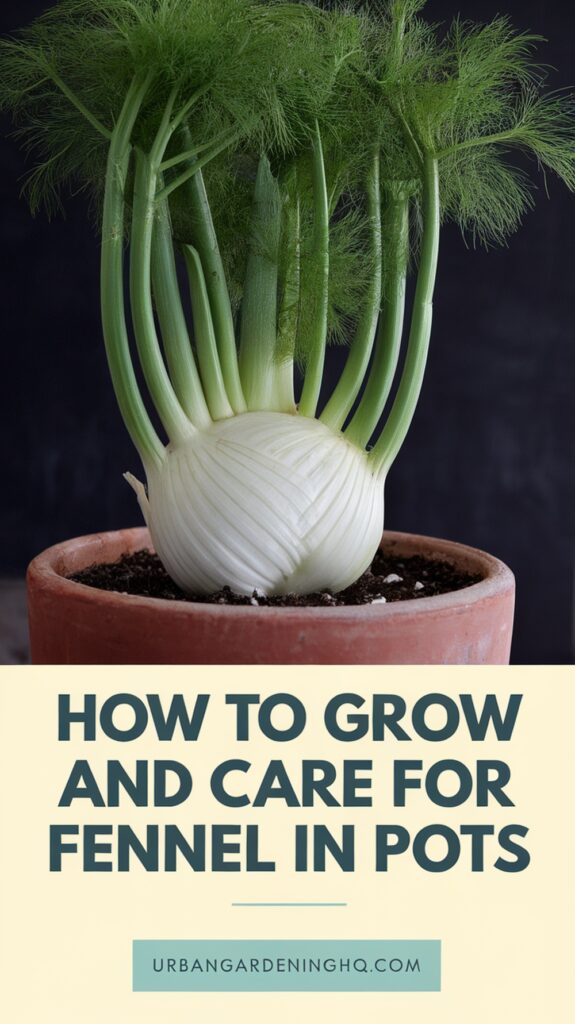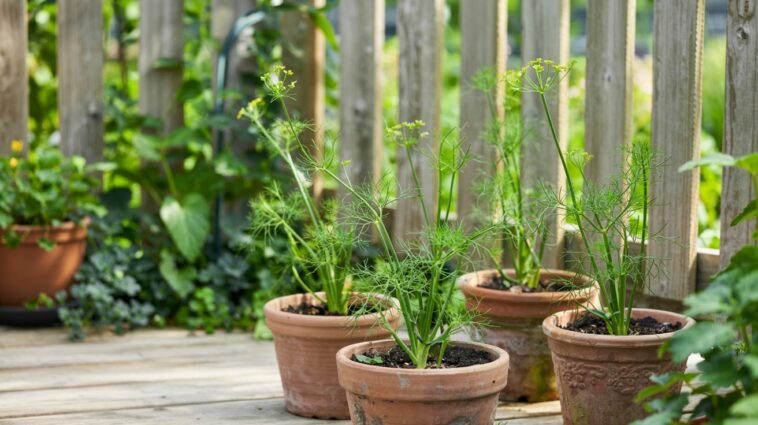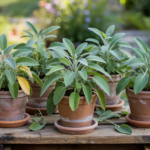I’ve learned that growing fennel in pots is rewarding. Its anise-flavored leaves and tender bulbs are great for dishes like roasted fish. This makes it a must-have in the kitchen.
Container gardening with fennel saves space and makes pest control easier. This guide will help you grow fennel in pots without common mistakes. Starting with the right pot, like a large trough, is essential.
For the best soil, use Scotts Osmocote® Plus Organics Tomato, Vegetable & Herb Potting Mix. Fennel loves sandy loam with a pH of 6–8. It needs full sun and regular water to stay healthy.
In this article, you’ll learn how to plant and care for fennel in pots. From planting seeds to harvesting bulbs in 90 days. Let’s create a thriving fennel garden, even in small spaces!
Introduction to Fennel: A Versatile Herb for Container Gardening

Adding fennel to your container garden is exciting. It brings a unique flavor and beauty to small spaces. With the right care, fennel can thrive in pots, making it perfect for container gardening.
Choosing the Right Varieties for Pots
Not all fennel is good for pots, but these are:
| Variety | Maturity Time | Best Use |
|---|---|---|
| ‘Fino’ | 75 days | Quick harvest for tender leaves and bulbs |
| ‘Finale’ | 80 days | Long harvest window for salads and cooking |
| ‘Zefa Fino’ | 80–90 days | Compact growth ideal for smaller containers |
Why Pots Outperform Garden Beds
- Control soil quality: Pots let you use free-draining mixes to avoid root rot.
- Space efficiency: A 12-inch pot can hold 3 plants without overcrowding.
- Winter protection: Move pots indoors to extend growing seasons in colder zones.
Understanding Fennel’s Life Cycle
Fennel is usually grown as an annual, even though it’s biennial. It grows 4–6 feet tall, needing large pots (at least 16 inches deep). In spring, leaves grow, followed by bulbs or seeds.
Harvest bulbs when they’re about the size of a tennis ball to avoid bitterness. Hot weather over 77°F stops bulb growth. So, plan your planting dates carefully.
Why I Love Growing Fennel in Containers
Growing Fennel Plant in Pots has changed my small urban garden. It’s perfect for those with little space. My patio now has fennel pots that do well in full sun. They look great next to dwarf lavender and succulents.
- Easy maintenance: Once established, it’s drought-tolerant and needs only weekly watering
- Flexible placement: Move pots indoors during frost to protect tender growth
- Edible beauty: Lacy foliage and yellow flower clusters attract pollinators like swallowtail butterflies
| Benefit | Key Detail |
|---|---|
| Space Efficiency | 30cm+ pots accommodate full growth cycles |
| Design Flexibility | Looks stunning with ornamental grasses or in Mediterranean herb groupings |
| Harvesting Convenience | Clip fresh fronds anytime without damaging root systems |
In summer, the feathery fronds of fennel look amazing with red geraniums. The flowers also attract ladybugs, which help control aphids. By using pots, I avoid soil problems. I mix multi-purpose compost with perlite for the best drainage.
Fennel in containers is rewarding all year. It’s great in fish dishes and attracts pollinators. With each trim, it keeps growing.
Selecting the Right Pots for Your Fennel Plants
 Fennel needs deep pots that breathe well. Here’s how to pick the best containers for your fennel.
Fennel needs deep pots that breathe well. Here’s how to pick the best containers for your fennel.
Ideal Pot Size and Material
Depth is the most important factor. Your pot should be at least 12–14 inches deep and 10–12 inches wide. For bulb fennel, aim for 30cm (12in) in both directions. Different materials offer different benefits:
| Material | Pros | Cons |
|---|---|---|
| Terracotta | Breathable, durable | Heavy, dries quickly |
| Plastic | Lightweight, affordable | Retains heat, less airflow |
| Fabric Grow Bags | Self-aerating, flexible | Less sturdy, may need sun protection |
Drainage Requirements for Healthy Fennel
Make sure your pots have drainage holes. Use a coffee filter at the bottom to prevent soil loss. For Fennel Plant in Pots, avoid soggy roots by emptying saucers after watering. Fabric pots naturally aerate soil but need frequent checks.
Space Considerations for Mature Fennel Plants
Give fennel 18–24 inches of space between pots. Herb varieties need 10-inch pots, while bulb types thrive in 14-inch containers. Use light-colored pots in hot climates to prevent overheating.
How to Grow and Care for Fennel in Pots
Learning How to Grow and Care for Fennel in Pots begins with sunlight. Place containers in full sun—6–8 hours daily—to mimic fennel’s Mediterranean heritage. I’ve found that south-facing patios or sunny balconies work best. Use pots at least 40cm wide and 30cm deep, like those with 3–5L capacity, to accommodate fennel’s deep roots. Add a 5cm gravel layer at the bottom for drainage.
I rely on Fennel Growing Tips like mixing Plantura Organic Tomato & Vegetable Compost with perlite for moisture retention without waterlogging.
Plant seeds 1cm deep, spacing them 30cm apart. Once seedlings emerge, thin to one plant per pot to prevent root disturbance. Mulch with straw or grass clippings to keep soil cool and moist—this is key for tender bulbs. Water consistently, aiming for damp soil but never soggy. During summer, I water twice weekly, adjusting for rain. Avoid overhead watering to prevent leaf diseases.
| Step | Action |
|---|---|
| Planting | Use pots ≥40cm wide with drainage holes |
| Soil | Blend potting mix + 20% perlite + 10% compost |
| Fertilizing | Apply Plantura Tomato Food every 4 weeks |
| Harvest | Cut bulbs when 5–8cm wide for best flavor |
Pair fennel with spinach or lettuce companions to deter pests naturally. Watch for bolting—harvest bulbs before flowering. For winter protection, move pots to sheltered areas if temperatures drop below 5°C. Using these Fennel Growing Tips ensures healthy growth, even in limited spaces. Adjust care based on your region’s climate, but always prioritize consistent moisture and sunlight.
Preparing the Perfect Soil Mix for Potted Fennel
Healthy fennel starts with the right soil mix. Fennel Potting Tips focus on balancing nutrients and drainage. This supports strong root growth. Using the right ingredients helps plants resist disease and produce flavorful foliage.
Optimal Soil pH for Fennel Container Gardening
Fennel thrives in slightly alkaline conditions. Aim for a pH between 6.5 and 7.5. Test your soil with a home kit and adjust if needed.
Add lime to raise pH or sulfur to lower it. A proper pH level prevents nutrient deficiencies.
Organic Amendments to Enhance Fennel Growth
- Mix in 20% compost or well-rotted manure to boost fertility.
- Add 5-10% worm castings for natural nutrients.
- Use a balanced organic fertilizer at planting time for extra nutrition.
Creating a Well-Draining Potting Medium
My go-to mix combines:
- 60% quality potting soil as a base.
- 20% compost for nutrients.
- 10% perlite or coarse sand for airflow.
- 10% coco coir to retain moisture without waterlogging.
This blend prevents root rot while keeping soil loose. Fennel Growing Tips emphasize avoiding heavy soils. Always prioritize drainage to protect roots from drowning.
Planting Fennel Seeds and Seedlings in Containers
I start my fennel by sowing seeds ½ inch deep in large containers. Choose pots at least 12 inches wide and deep. Fill them with multi-purpose compost mixed with Miracle-Gro Potting Mix. Sow seeds in spring after frost, spacing them 1 foot apart.
Water gently until sprouts appear. Soil should stay moist but never waterlogged.
Transplanting seedlings needs care. Use biodegradable pots when starting indoors to avoid root damage. Slide the entire pot into your permanent container without removing the plant.
Bury the pot halfway into the soil and water thoroughly. For nursery-bought plants, gently transfer the root ball intact into your container. Space plants 12 inches apart to prevent overcrowding.
- Sow seeds ½ inch deep in 12-inch-wide containers
- Thin seedlings to 12 inches apart once they’re 3 inches tall
- Use biodegradable pots to minimize root disturbance
- Protect young plants with copper slug pellets
Watch for leggy seedlings and pinch back overgrowth to encourage bushy growth. Fennel Container Care begins with proper planting—root health is vital. Water at soil level to avoid rot.
Newly planted seedlings need 6 hours of sunlight daily to thrive. With these steps, your container-grown fennel will establish strong roots for season-long growth.
Essential Watering and Feeding Tips for Container Fennel
Starting with Fennel Plant Care means knowing about moisture and nutrients. Potted fennel needs regular care to stay healthy in small spaces. Here’s how to keep your plants happy all season.
Check the soil weekly by sticking your finger in it. Water deeply when the top inch is dry. This stops overwatering, a big problem in Fennel Container Care. Mulch with grass clippings to keep moisture in and add nitrogen as they break down.
Watch for Water Stress Signs
- Yellow leaves? Back off watering—root rot from overwatering is often to blame.
- Wilting or crispy edges? Increase frequency—drought stress slows growth.
Feed Strategically for Strong Growth
Begin with compost-rich soil when planting. For more nutrients, apply a balanced 5-5-5 organic fertilizer in spring. Use Down to Earth Blood Meal early, then switch to phosphorus-rich feeds when flowers bloom. Make nettle tea every four weeks for a natural boost.
Dealing With Common Fennel Plant Problems in Pots
Even with the right care, container-grown fennel can face issues. Pests like aphids and parsleyworms are common. Aphids are small, soft insects, and parsleyworms are bright green caterpillars with black and yellow stripes. While parsleyworms turn into black swallowtail butterflies, it’s important to remove them if they eat too much.
Here’s how to tackle these problems:
- Aphids: Use insecticidal soap or attract ladybugs. Always check the underside of leaves.
- Parsleyworms: Keep a few for pollinators, but remove the rest by hand.
- Armyworms: They eat leaves. Use Bacillus thuringiensis for organic control.
- Slugs/snails: Use diatomaceous earth or pick them up at night.
- Cutworms: Protect seedlings with foil collars around the stems.
Diseases like powdery mildew (white on leaves) love humid air. Cut off infected parts and improve air flow. Root rot from too much water needs pots with holes for drainage. For nutrient issues, fertilize every month with a balanced mix.
Bolting—early flowering—can happen from stress or cold. Choose varieties like ‘Roma’ that grow slower. Avoid sudden temperature changes. Tall plants might fall over; use stakes in big pots.
For quick fixes, check your plants weekly, adjust watering, and act fast. Early action keeps your fennel healthy all year.
Indoor Fennel Plant Care: Growing Fennel Year-Round

Bringing fennel indoors lets you enjoy its licorice-flavored leaves all year. My tips focus on balancing its needs for light, warmth, and space. Let’s start with the basics.
Light Requirements for Indoor Fennel
Fennel plants in pots need 6-8 hours of direct sunlight daily. South-facing windows are best. If natural light is limited, use full-spectrum grow lights for 12-16 hours. This setup boosts growth even in winter.
Temperature and Humidity Considerations
- Keep temps between 60-70°F during the day; allow 10°F cooler at night.
- Use pebble trays or misters to add humidity without overwatering.
- Position plants away from heating vents to avoid dry air stress.
Seasonal Adaptations for Indoor Fennel Plants
Move outdoor Fennel plants inside before frost. Gradually acclimate them over a week to avoid shock. Reduce watering and feeding during winter dormancy, resuming in spring. Prune dead leaves to encourage new growth.
Harvesting Your Container-Grown Fennel
Harvesting your container-grown fennel is a rewarding part of your fennel growing journey. Follow these Fennel Growing Tips to get the most from your plants. Growing Fennel in Containers makes harvesting easy.
Start picking leaves once stems reach 12 inches tall. Snip outer fronds regularly to encourage bushier growth. For bulbs, wait until they swell to 3–4 inches wide—about the size of a tennis ball.
Use a sharp knife to cut the bulb just above soil level. Seeds are ready when they turn brown; collect them by shaking the flower head over a container.
Timing matters. Most varieties are ready in 80–110 days after planting. Leaves can be harvested continuously, but never remove more than a third at once.
Bulbs taste best before flowering—check their size weekly. Store unwashed bulbs in the fridge for 3–5 days. Leaves last longer in a glass of water on the counter.
Here’s what to do next:
- Cut bulbs when they reach 3–4 inches in diameter.
- Snip leaves from the outer stems first.
- Let seeds dry completely before storing in airtight containers.
Maximize your harvest by using all parts: add fronds to salads, roast bulbs for sweetness, and sprinkle seeds in breads or teas. Regular harvesting keeps plants productive and bushy. With these steps, your potted fennel will reward you with flavor and flexibility all season long.
Conclusion: Enjoying the Rewards of Your Potted Fennel Garden
Growing fennel in pots is a great adventure for gardeners of all levels. It brings beauty and flavor to your space, whether on a balcony or in recipes. I’ve found that with a little care, even small spaces can bloom with fennel.
Start by picking deep pots with good drainage. Keep the soil balanced and prune often. This way, you’ll have fresh fennel all season.
Fennel is more than just a flavor for food. Its tall stems add elegance to any spot. I’ve mixed it with tomatoes and marigolds for a colorful, pest-repellent display. The bulb is great in salads, and the seeds add flavor to breads and stews.
Container gardening with fennel is also eco-friendly. It saves space and lets you control the soil, which fennel loves. Try different types like Florence for bulbs or bronze for foliage. Share your success stories on social media with #FennelContainerGardening. Let’s encourage others to grow this versatile herb at home.


